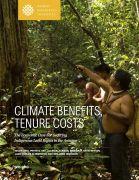Bermanfaat Bagi Iklim, Merugikan Kepemilikan
Kasus Ekonomi dalam Mengamankan Hak Tanah Adat di Amazon

Ringkasan
Laporan ini untuk pertama kalinya melakukan perhitungan kuantitatif akan nilai ekonomi dari pengamanan hak atas lahan bagi masyarakat yang tinggal di dalam hutan dan melindungi hutan, dengan fokus utama pada Kolombia, Brazil, dan Bolivia.
Temuan Utama
Laporan ini membuktikan bahwa investasi sederhana yang dibutuhkan untuk mengamankan hak atas tanah bagi masyarakat adat akan membuahkan hasil yang bernilai miliaran - baik dari segi ekonomi, sosial, dan lingkungan - yang membawa manfaat bagi masyarakat lokal dan juga bagi iklim dunia yang semakin berubah.
Ringkasan Utama
Laporan ini untuk sementara hanya tersedia dalam Bahasa Inggris.
This report presents the findings of benefit-cost analysis for securing indigenous forestland tenure in the Amazon basin of Bolivia, Brazil, and Colombia. These countries were selected primarily because they include a significant portion of the Amazon basin forest and the governments have formally recognized many indigenous lands. The research builds on WRI’s recently published working paper, The Economic Costs and Benefits of Securing Community Forest Tenure: Evidence from Brazil and Guatemala. It provides original matching analysis on deforestation rates, incorporates carbon sequestration and an array of other ecosystem services into the benefit-cost analysis, and provides a set of policy and program recommendations for finance and land use planning ministry officials and their partners.
The matching analysis shows that for the 12-year period between 2000 and 2012, the annual deforestation rates inside tenure-secure indigenous forestlands were significantly lower than those outside in Bolivia (2.8 times lower), Brazil (2.5 times lower), and Colombia (2 times lower). The benefitcost analysis shows that securing indigenous forestland tenure is a low-cost, high-benefit investment. The estimated economic benefits for a 20-year period are: $54–119 billion for Bolivia; $523–1,165 billion for Brazil; and $123–277 billion for Colombia. Costs amount to at most 1 percent of the total benefits. From a financial perspective, investing in securing indigenous forestland tenure is also a relatively cost-effective measure for climate change mitigation when compared with other carbon capture and storage measures—the costs of securing tenure are 5 to 29 times lower than the estimated costs for coal-fired power plants and 7 to 42 times lower than for natural gas-fired power plants.
These findings make a strong economic case for governments, climate change funding agencies, and other partners to invest in securing indigenous forestland tenure in Latin America, and, more broadly, community land rights around the world. Recommendations include: establish land laws that protect community land rights; remove administrative and other hurdles that stifle the registration and formal recognition of community land; make tenure-secure community forestlands a central climate change mitigation strategy; and utilize international climate and development funds to help document and protect community land rights. Securing indigenous and community forestlands tenure is a low-cost solution that can help governments achieve the climate goals in their Nationally Determined Contributions (NDCs).